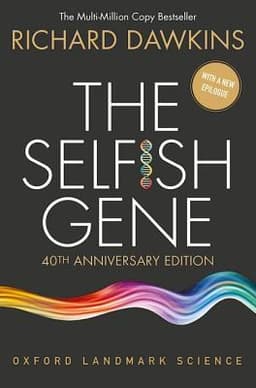Summary
"The Selfish Gene" revolutionizes our understanding of evolution by arguing that genes, not individuals or species, are the fundamental units of natural selection, driving the behaviors and adaptations we observe in living organisms through their relentless pursuit of self-replication.
Sign in to rate
Average Rating: 2
The Primacy of Natural Selection
Darwin's theory of evolution by natural selection is the only known explanation for the existence of life that can account for its complexity. The chapter argues that natural selection operates at the level of genes, not species or groups. This gene-centric view helps explain behaviors that may seem altruistic but actually serve to propagate an organism's genes.
Section: 1, Chapter: 1
Misconceptions About Group Selection
Dawkins systematically dismantles the theory of group selection, which suggests that organisms act for the good of their species. He points out several flaws in this thinking, such as the inability to explain how altruistic traits would initially spread within a population.
The author argues that selfish individuals would invariably outcompete altruistic ones within a group, and there's no clear mechanism to prevent "cheating" in a group-selection model. Instead, Dawkins proposes that gene-level selection provides a more robust and logically consistent explanation for observed behaviors in nature, including those that appear altruistic on the surface.
Section: 1, Chapter: 1
The Power of Cumulative Selection
To illustrate the power of cumulative selection versus pure chance, Dawkins employs the analogy of monkeys typing Shakespeare. While the odds of monkeys randomly producing a coherent phrase from Shakespeare are astronomically low, a process that builds on small improvements each generation can produce complex adaptations relatively quickly.
This analogy serves to demonstrate how natural selection operates to create the appearance of design in nature, without the need for a conscious designer. The author uses this example to bridge the gap between the seemingly impossible complexity of life and the gradual, cumulative power of natural selection acting on genes over millions of years.
Section: 1, Chapter: 1
The Origin of Life
This chapter delves into the hypothetical origins of life on Earth, exploring how the first self-replicating molecules might have arisen in the "primordial soup" of the early planet. Dawkins describes how these simple replicators would have competed for resources, with more efficient replicators outcompeting others. Over time, these replicators developed increasingly complex "survival machines" (bodies) to help them reproduce more effectively. The author draws a direct line from these primordial replicators to modern genes, establishing them as the fundamental units of evolution and the driving force behind all life on Earth.
Section: 1, Chapter: 2
Qualities of Successful Replicators
Dawkins identifies three key characteristics that define successful replicators: longevity, fecundity, and copying-fidelity. Longevity refers to the ability to persist for long periods, allowing more opportunities for replication. Fecundity is the capacity to make many copies of itself, increasing the replicator's presence in the population.
Copying-fidelity ensures that the replicator can be copied accurately, preserving its structure and properties across generations. The author argues that replicators possessing these qualities would inevitably come to dominate the gene pool over time, driving the evolution of increasingly complex and efficient survival machines.
Section: 1, Chapter: 2
The Mechanics of Genetic Inheritance
Chapter 3 provides a detailed exploration of how genes are passed down through generations. Dawkins explains key concepts such as chromosomes, alleles, and the process of meiosis, which creates gametes with unique genetic combinations.
He emphasizes that while individual bodies are temporary vehicles, genes have the potential for immortality by being copied and passed on indefinitely. This chapter lays the groundwork for understanding the complex interplay between genes and the organisms they construct, setting the stage for later discussions on gene cooperation and competition.
Section: 1, Chapter: 3
Introducing the Extended Phenotype
In this chapter, Dawkins introduces the groundbreaking concept of the extended phenotype, which will be fully developed later in the book. This idea challenges the traditional view that genes only affect the body they're in, proposing instead that a gene's effects can extend far beyond the individual organism.
The author provides examples such as beaver dams, which can be seen as extended phenotypes of beaver genes, and parasites that manipulate host behavior. This concept has profound implications for our understanding of how natural selection operates, encouraging readers to consider the broader environmental impacts of genetic evolution. The extended phenotype idea serves as a powerful tool for reframing our perspective on the relationship between genes, organisms, and their environments.
Section: 1, Chapter: 3
The Body as a Survival Machine
Dawkins introduces the concept of the body as a "survival machine" for genes. He explains that organisms are intricate, purposeful constructions designed to propagate the genes they contain. The chapter explores how genes influence behavior through their effects on the nervous system, drawing analogies between animal bodies and man-made machines. While genes "program" the overall structure and function of the body, they do not directly control moment-to-moment actions.
Section: 1, Chapter: 4
The Illusion of Central Control
The author challenges the notion of a centralized "self" controlling the body. Instead, he proposes that behavior emerges from the complex interactions of genes, neurons, and environmental stimuli. This decentralized view of behavior has several implications:
- There is no single "control center" in the brain
- Behavior is the result of competing genetic influences
- The appearance of purposeful action arises from underlying genetic programming
- Consciousness and free will may be illusory byproducts of this system
This perspective encourages us to reconsider their understanding of agency and decision-making in both humans and animals.
Section: 1, Chapter: 4
Evolutionarily Stable Strategies
Chapter 5 introduces the concept of Evolutionarily Stable Strategies (ESS), developed by John Maynard Smith. An ESS is a behavioral strategy that, if adopted by most members of a population, cannot be outcompeted by any alternative strategy. Dawkins uses game theory to explain how certain behaviors, particularly those related to aggression and cooperation, can become stable within a population. The chapter explores various scenarios, such as the famous "Hawk-Dove" game, to illustrate how seemingly altruistic or restrained behaviors can emerge from selfish genetic interests.
Section: 1, Chapter: 5
The Adaptive Logic of Animal Conflict
Dawkins examines how aggressive behaviors in animals are often more restrained than one might expect from a "selfish gene" perspective. He explains that this restraint is actually in the genetic self-interest of individuals, as excessive aggression can be costly. The chapter outlines several key insights:
- Ritualized combat often replaces lethal fighting
- Individuals assess each other's fighting ability to avoid unnecessary conflicts
- Territorial behavior can be an ESS, reducing overall conflict
- Apparently altruistic behaviors can be explained through genetic self-interest
Section: 1, Chapter: 5
Kinship and Genetic Relatedness
Chapter 6 goes into the intricacies of kin selection and how genes promote their own survival through relatives. Dawkins explains Hamilton's rule, which states that altruistic behavior will be favored by natural selection when the cost to the altruist is outweighed by the benefit to the recipient, multiplied by their degree of genetic relatedness. This concept helps explain various forms of apparent altruism in nature, from parental care to the complex social structures of insects like ants and bees.
Section: 1, Chapter: 6
The Mathematics of Relatedness
Dawkins provides a detailed explanation of how genetic relatedness is calculated and its implications for behavior. He introduces the concept of "coefficient of relatedness" and shows how it varies for different family relationships. For example:
- Parent to child: 1/2
- Full siblings: 1/2
- Half siblings: 1/4
- Grandparent to grandchild: 1/4
- First cousins: 1/8
Understanding these relationships helps predict the likelihood and extent of altruistic behaviors between relatives. The chapter also explores how this framework can be applied to understand complex social behaviors in both animals and humans.
Section: 1, Chapter: 6
The Evolution of Family Size
Dawkins explores how natural selection influences the number of offspring animals produce. He introduces Lack's principle, which states that the most common clutch or litter size in a population should be the one that maximizes the number of surviving offspring. The chapter examines the trade-offs between quantity and quality of offspring, explaining how factors such as parental investment and environmental conditions shape reproductive strategies.
Section: 1, Chapter: 7
Parental Investment and Sexual Conflict
The chapter delves into the concept of parental investment, introduced by Robert Trivers. It explains how the relative investment of males and females in their offspring can lead to sexual conflict and shape mating systems. Dawkins discusses how this framework helps explain phenomena such as:
- Why females are often more choosy about mates
- The evolution of male ornaments and displays
- Patterns of parental care across species
- The occurrence of infanticide in some animals
Section: 1, Chapter: 7
Parent-Offspring Conflict
This chapter focuses on the genetic conflict between parents and their offspring. Dawkins explains that while parents are equally related to all their offspring, each individual offspring is more related to itself than to its siblings. This leads to a conflict of interest, where offspring may demand more resources than parents are selected to provide. The chapter explores how this conflict manifests in nature and shapes the evolution of parental care strategies.
Section: 1, Chapter: 8
Genomic Imprinting and Intergenerational Conflict
The chapter introduces the concept of genomic imprinting, where genes are expressed differently depending on whether they are inherited from the mother or father.
Dawkins explains how this phenomenon can be understood as a result of evolutionary conflict between maternal and paternal genes within an offspring. This framework helps explain various developmental disorders and provides insights into the evolution of complex genetic regulation.
Section: 1, Chapter: 8
The Evolution of Sex Ratios
Dawkins delves into Fisher's principle, which explains why sex ratios in most species tend to be 1:1. He outlines the evolutionary logic:
- If one sex becomes scarce, individuals of that sex have a reproductive advantage
- Parents who produce the scarcer sex will have more grandchildren
- This leads to an evolutionary pressure balancing the sex ratio
- Deviations from 1:1 can occur under specific circumstances (e.g., in some insect species)
Section: 1, Chapter: 9
Reciprocal Altruism in Action
Dawkins describes the intricacies of reciprocal altruism using the example of cleaner fish and their clients. Cleaner wrasses set up "cleaning stations" on coral reefs, where larger fish come to have parasites removed. The remarkable aspect of this relationship is that predatory clients refrain from eating the cleaner fish, despite the obvious opportunity.
Dawkins explains how this behavior evolved: cleaners that efficiently remove parasites are more likely to be revisited, while clients that resist the temptation to eat cleaners benefit from long-term parasite removal. This mutual restraint is enforced by the prospect of future interactions, demonstrating how cooperation can emerge from self-interest when there's a possibility of repeated encounters.
Section: 1, Chapter: 10
The Evolutionary Logic of Tit for Tat
The chapter explores Robert Axelrod's computer tournaments that tested various strategies in the Iterated Prisoner's Dilemma. The simple strategy of Tit for Tat, submitted by Anatol Rapoport, emerged as the winner. Dawkins breaks down why this strategy is so effective:
- It starts by cooperating, avoiding unnecessary conflict
- It retaliates immediately if the opponent defects, discouraging exploitation
- It forgives quickly, allowing for the restoration of mutual cooperation
- It's clear and predictable, making it easy for others to understand and cooperate with
This analysis shows how a simple, cooperative strategy can outperform more complex or aggressive approaches in the long run, providing insights into the evolution of cooperation in nature and human societies.
Section: 1, Chapter: 10
The Mechanics of Memetic Transmission
Dawkins introduces memes as cultural replicators, analogous to genes but in the realm of ideas and behaviors. He explains the process of memetic transmission using examples like the spread of a scientific theory or a catchy tune. Memes replicate through imitation, passing from brain to brain via language, demonstration, or other forms of communication.
Memes can mutate and evolve as they spread, with some variations being more successful than others. For instance, a joke might be retold with slight modifications, and the version that elicits the most laughter is more likely to be remembered and retold. This process of variation and selection leads to the evolution of memes over time, shaping human culture in ways that may be independent of genetic influences.
Section: 1, Chapter: 11
Memes and the Human Brain
Dawkins examines the relationship between memes and the human brain, suggesting that our large brains and capacity for imitation have made us especially susceptible to memetic influence. He proposes that the human mind can be viewed as an arena where memes compete for attention and retention. This perspective offers new insights into human behavior and culture:
- It suggests that some behaviors might be better explained by memetic rather than genetic evolution
- It raises questions about the nature of human consciousness and free will
- It provides a framework for understanding the rapid changes in human culture compared to the slower pace of genetic evolution
- It offers a new approach to studying cultural phenomena, from religious beliefs to fashion trends
Section: 1, Chapter: 11
The Biology of Forgiveness
Dawkins explores the evolutionary basis of forgiveness using the Iterated Prisoner's Dilemma model. He explains that while retaliation against cheaters is important, the ability to forgive and return to cooperation is equally crucial.
The chapter examines strategies like "Tit for Two Tats," which only retaliates after two consecutive defections, showing how increased forgiveness can sometimes be advantageous. This framework helps explain why forgiveness and reconciliation are common in nature, despite the apparent advantages of holding grudges.
Section: 1, Chapter: 12
Parasitic Manipulation as Extended Phenotype
Dawkins provides a detailed examination of how parasites manipulate host behavior as an example of extended phenotype. He discusses the lancet fluke, which infects ants and causes them to climb to the tops of grass blades, increasing the likelihood of being eaten by sheep (the fluke's final host).
The chapter explores the biochemical and neural mechanisms by which the fluke genes influence ant behavior, emphasizing that this manipulation is just as much a phenotypic expression of the fluke's genes as its own body shape. Dawkins extends this concept to other examples, such as cuckoo chicks manipulating host bird behavior, to show how genes can have far-reaching effects beyond the bodies in which they reside. This perspective challenges traditional notions of individual organisms and highlights the interconnectedness of genetic influences in ecosystems.
Section: 1, Chapter: 13
Redefining the Individual in Light of Extended Phenotypes
Dawkins challenges readers to reconsider the concept of individual organisms in light of the extended phenotype theory. He argues that the boundaries of an individual are not as clear-cut as traditionally thought, given that genes can exert influences far beyond the body they inhabit. This has several implications:
- It suggests a new way of understanding adaptation, focusing on genes rather than organisms
- It provides a framework for analyzing complex ecological relationships
- It offers insights into the evolution of animal artifacts and behaviors
- It raises philosophical questions about the nature of identity and self
The chapter encourages a shift in perspective, viewing the living world as a complex network of genetic influences rather than a collection of discrete individuals.
Section: 1, Chapter: 13
Related Content


The Sixth Extinction Book Summary
Elizabeth Kolbert
In "The Sixth Extinction," Elizabeth Kolbert takes us on a riveting journey through the tumultuous history of life on Earth, revealing how human activity is driving a catastrophic modern extinction event that may ultimately imperil our own survival.
In "The Sixth Extinction," Elizabeth Kolbert takes us on a riveting journey through the tumultuous history of life on Earth, revealing how human activity is driving a catastrophic modern extinction event that may ultimately imperil our own survival.
Nature
History
Climate Change


